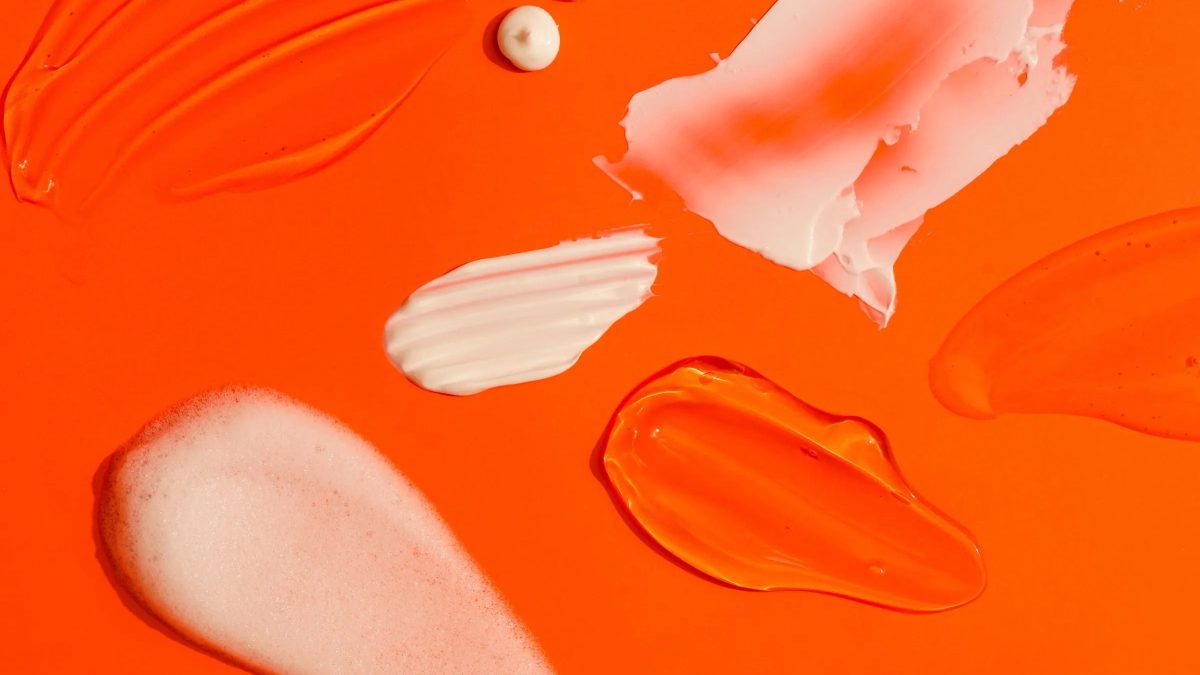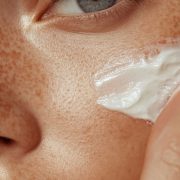Signs your skin is overloaded—and how to reset with a simple regimen
Posted on August 4, 2025 Written by: 100% PURE®

Your bathroom counter tells a story. Serums lined up like soldiers, moisturizers for every concern imaginable, acids and actives promising transformation. You’ve invested time, money, and hope into each bottle, following every step religiously. Yet somehow, your skin looks worse than before you started this elaborate routine. Sound familiar?
You’re not alone. In our quest for perfect skin, many of us have fallen into the “more is better” trap, layering product after product in hopes of addressing every possible concern. But here’s what the beauty industry won’t tell you: there’s a very real phenomenon called product overload, and it might be sabotaging all your skincare efforts.
The good news? Recognizing the signs of an overloaded routine is the first step toward healthier skin. Even better, the solution—a strategic skin reset—is simpler than you might think. Let’s explore how to identify if you’re using too many products and, more importantly, how to get your skin back on track.
The Hidden Cost of Skincare Enthusiasm
We live in an era of skincare abundance. Social media influencers showcase 12-step routines, beauty stores offer endless options, and new “miracle” ingredients launch weekly. It’s easy to believe that addressing every skin concern requires a dedicated product. Dry patches? Add a hydrating serum. Fine lines? Layer on the retinol. Dullness? Time for vitamin C. Before you know it, your evening routine takes 30 minutes and involves more products than a professional facial.
But skin has limits. Unlike what marketing might suggest, our skin isn’t designed to absorb unlimited amounts of product. When we exceed these limits, we create problems rather than solving them. Think of it like nutrition—while vitamins are essential, taking excessive supplements doesn’t make you extra healthy. In fact, it can cause harm. The same principle applies to skincare.

Warning Signs Your Skin Is Crying “Uncle”
How do you know when you’ve crossed the line from thorough to excessive? Your skin will tell you, often in ways you might not immediately recognize as product overload. Here are the key signs to watch for:
1. The Paradox of Simultaneous Dryness and Oiliness
One of the most confusing signs of product overload is when your skin can’t seem to make up its mind. You might notice oily patches alongside areas of flaking or tightness. This contradiction occurs when excessive product use disrupts your skin’s natural balance. Your moisture barrier becomes compromised, leading to water loss (hence the dryness), while your sebaceous glands go into overdrive trying to compensate (creating oiliness).
2. Increased Sensitivity and Reactivity
Remember when your skin was relatively calm? If you’re now experiencing stinging, burning, or redness from products that never bothered you before, overload might be the culprit. When skin is overwhelmed, its tolerance threshold drops dramatically. Products you’ve used for years might suddenly cause irritation because your skin’s protective barrier has been weakened by excessive product layering.
3. Texture Changes You Can’t Explain
Mysterious bumps, rough patches, or a generally congested appearance often signal product buildup. When you layer multiple products, not everything absorbs properly. Residue sits on the skin’s surface, mixing with dead skin cells and sebum to create texture issues. These aren’t typical acne breakouts but rather small, flesh-colored bumps that make skin feel rough and look dull.
4. The Dreaded Product Pilling
If your carefully applied products ball up and roll off your skin like eraser shavings, you’re definitely using too much. Product pilling occurs when formulations don’t play well together or when skin simply can’t absorb any more. It’s a clear sign that your layering has exceeded what your skin can handle.
5. Persistent Inflammation
Chronic redness, warmth, or that constant feeling of irritation indicates skin inflammation from overuse of skincare. This low-grade inflammation might not look dramatic, but it prevents skin from functioning optimally and can accelerate aging—the opposite of what most skincare routines aim to achieve.
6. Breakouts Despite “Anti-Acne” Products
Ironically, using multiple acne-fighting products often worsens breakouts. Over-treating disrupts the skin barrier, leading to increased bacteria penetration and inflammation. If you’re breaking out more despite using salicylic acid, benzoyl peroxide, and retinoids all at once, product overload is likely to blame.
The Science Behind Skin Overload
To understand why less can be more, it’s helpful to know how skin actually processes products. Your skin isn’t a sponge that infinitely absorbs whatever you apply. Instead, it has specific pathways for ingredient penetration, and these pathways have capacity limits.
The stratum corneum, your skin’s outermost layer, acts as both a barrier and a gateway. When functioning properly, it allows beneficial ingredients to penetrate while keeping irritants out. However, when you apply multiple products in succession, you can:
- Alter the skin’s pH balance
- Disrupt the lipid barrier
- Create chemical interactions between ingredients
- Overwhelm the skin’s absorption capacity
- Trigger inflammatory responses
Each product you apply changes the skin’s surface environment. When you layer multiple products quickly, you’re constantly shifting this environment before skin can adapt, creating chaos rather than care.

Your Skin Reset Action Plan
Ready to give your skin a fresh start? A strategic skin reset doesn’t mean abandoning skincare altogether. Instead, it’s about stripping back to essentials and allowing your skin to rebalance. Here’s your step-by-step guide:
Week 1-2: The Elimination Phase
Start by putting aside all active treatments, serums, and extras. Your goal is to use only the absolute basics:
Morning:
- Rinse with lukewarm water (skip cleanser if skin isn’t oily)
- Apply a simple, fragrance-free moisturizer
- Finish with SPF
Evening:
- Gentle cleanse to remove sunscreen and daily buildup
- Apply the same simple moisturizer
- Nothing else
This phase might feel strange, especially if you’re used to elaborate routines. Resist the urge to add “just one serum.” Your skin needs this break to reset its natural functions.
Week 3-4: Strategic Reintroduction
Once your skin has calmed (you’ll notice reduced redness, fewer breakouts, and improved texture), you can begin thoughtfully rebuilding your routine. Start with addressing your primary skin concern—just one.
For cleansing, consider a gentle option like the 100% PURE Blood Orange Cleansing Balm for evening removal of sunscreen and makeup. Its simple, effective formula removes impurities without stripping skin. For those with sensitive or reactive skin, the 100% PURE Lavender Oat Milk Soothing Cleanser provides an ultra-gentle option that supports skin recovery.
For hydration, the 100% PURE Rose Water Hydrating Milk offers lightweight moisture without overwhelming recovering skin. Its minimal ingredient list makes it ideal during a skin reset when you want effective hydration without unnecessary extras.
Week 5-6: Assess and Adjust
By now, your skin should show significant improvement. This is when you can evaluate whether you need additional products. The key is adding one product at a time and waiting at least a week before introducing another. This way, you can identify what truly benefits your skin versus what might cause problems.
If you need additional antioxidant protection, the 100% PURE Green Tea EGCG Concentrate Cream provides concentrated benefits without requiring multiple layered serums. For daytime protection, the 100% PURE Yerba Mate Mist SPF 30 offers sun protection with added antioxidants, eliminating the need for separate antioxidant serums under sunscreen.
Building a Sustainable Routine Post-Reset
After successfully resetting your skin, the goal is maintaining its newfound balance. Here are principles for a sustainable routine:
Quality Over Quantity
Invest in well-formulated products that address multiple concerns rather than using single-purpose products for everything. A good moisturizer should hydrate, support barrier function, and provide some antioxidant benefits—eliminating the need for multiple products.
Respect Product Compatibility
Not all ingredients play well together. Vitamin C and retinol, for example, can deactivate each other when layered. AHAs and BHAs used together might cause excessive irritation. Research ingredient interactions or simplify by using different actives on different days.
Listen to Your Skin
Your skin’s needs change with seasons, hormones, stress, and age. What works in summer might be insufficient in winter. Rather than maintaining a rigid routine, adjust based on what your skin tells you.
The Two-Week Rule
When introducing new products post-reset, follow the two-week rule: use a new product for at least two weeks before adding anything else. This allows you to properly assess its effects and identify any negative reactions.
Common Mistakes During a Skin Detox
Even with the best intentions, it’s easy to sabotage your skin reset. Avoid these common pitfalls:
Giving Up Too Soon
The first week of a skin detox might bring purging or temporary dryness as skin adjusts. This is normal. Don’t panic and return to your old routine. Give the process at least two weeks before evaluating.
Secret Product Use
“Just a little vitamin C serum won’t hurt,” you might think. But any addition during the elimination phase defeats the purpose. Stay strong and stick to the basics.
Over-Cleansing
In an attempt to keep skin “clean” during reset, some people increase cleansing frequency or intensity. This strips natural oils and impedes barrier recovery. Gentle and minimal is the goal.
Ignoring Sun Protection
Sunscreen isn’t negotiable, even during a skin reset. Choose a simple, mineral-based formula if chemical sunscreens irritate your sensitized skin.
Understanding the Minimalist Mindset
Successfully resetting your skin often leads to a revelation: you need far less than you thought. This doesn’t mean becoming anti-skincare. Instead, it’s about being intentional with your choices. Consider these mindset shifts:
From “addressing everything” to “prioritizing primary concerns” You don’t need to tackle every minor imperfection simultaneously. Focus on your main skin goal and let overall skin health improve naturally.
From “more steps equal better care” to “effective formulations equal better results” A three-step routine with well-chosen products often outperforms a ten-step routine with mediocre formulations.
From “new is better” to “consistency is key” Constantly trying new products prevents you from seeing what actually works. Stick with products for at least two months before evaluating their effectiveness.
Special Considerations for Different Situations
Post-Procedure Care
If you’ve recently had professional treatments like chemical peels or laser procedures, your skin is especially vulnerable to product overload. Follow your provider’s recommendations exactly, resisting the urge to accelerate healing with additional products.
Hormonal Fluctuations
During menstruation, pregnancy, or menopause, skin sensitivity increases. These are times to simplify rather than complicate your routine, even if new concerns arise.
Seasonal Transitions
When weather changes dramatically, the instinct is to overhaul your entire routine. Instead, make one adjustment at a time, allowing skin to adapt gradually.
The Long-Term Benefits of Simplicity
Those who successfully reset their skin and maintain simpler routines report numerous benefits:
- Significant cost savings from buying fewer products
- Reduced morning and evening routine time
- Less anxiety about “doing it right”
- Improved skin barrier function
- Fewer unexpected reactions
- Better understanding of what their skin actually needs
- More consistent, predictable results
When to Seek Professional Help
While most cases of product overload resolve with a proper reset, some situations require professional intervention:
- Persistent dermatitis or eczema-like symptoms
- Severe cystic acne that worsens during reset
- Signs of allergic reactions (swelling, hives, difficulty breathing)
- Skin infections or open wounds
- No improvement after 4-6 weeks of simplified routine
A dermatologist can help identify underlying conditions that might be complicating your skin’s recovery and provide targeted treatments that work with your simplified routine.
Your Skin’s Fresh Start
Recognizing that you’re using too many products takes honesty and courage—it means admitting that your well-intentioned efforts might be causing harm. But this recognition is powerful. It’s the first step toward healthier, happier skin that doesn’t require a medicine cabinet full of products to look its best.
Remember, skin is remarkably resilient. Given the chance to reset and rebalance, it often surprises us with its ability to heal and thrive. Your skin detox journey might feel uncomfortable at first, especially if you’re attached to your extensive routine. But on the other side of this temporary discomfort lies clearer, calmer, more radiant skin achieved through simplicity rather than excess.
The path forward is clear: recognize the signs of overload, commit to a reset, and rebuild thoughtfully. Your skin—and your wallet—will thank you for choosing quality over quantity, intention over impulse, and simplicity over excess. Sometimes the best thing you can do for your skin is to simply do less.




